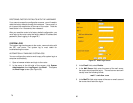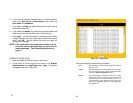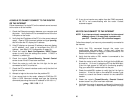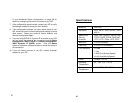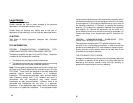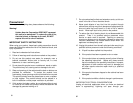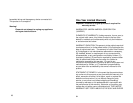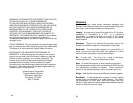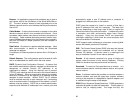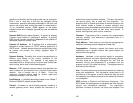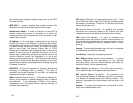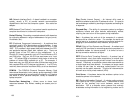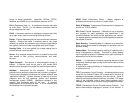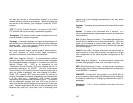101
has several large societies in special areas, such as the IEEE
Computer Society.
IEEE 802.11 - Industry standard that enables wireless LAN
hardware from different manufacturers to communicate.
Infrastructure Mode - A mode of operation of the 802.11b
wireless protocol that allows all computers on a wired and
wireless network to share a peripheral, such as a printer or high
speed Internet Access.
IP Address - In the most widely installed level of the Internet
Protocol (IP) today, and IP address is a 32-binary digit number
that identifies each sender or receiver of information that is sent
in packets across the Internet. When you request an HTML
page or send e-mail, the Internet Protocol part of TCP/IP
includes your IP address in the message (actually, in each of the
packets if more than one is required) and sends it to the IP
address that is obtained by looking up the domain name in the
Uniform Resource Locator you requested or in the e-mail
address you’re sending a note to. At the other end, the recipient
can see the IP address of the Web page requestor or the e-mail
sender and can respond by sending another message using the
IP address it received.
IPCONFIG – A utility that provides for querying, defining and
managing IP addresses within a network. This utility is
commonly used under Windows NT and 2000, for configuring
networks with a static IP address.
IPSec (Internet Protocol Security) - A developing standard for
security at the network or packet-processing layer of network
communication. A big advantage of IPSec is that security
arrangements can be handled without requiring changes to
individual user computers.
102
IRQ (Interrupt Request) – A hardware interrupt on a PC. There
are 16 IRQ lines used to signal the CPU that a peripheral event
has started or terminated. Except for PCI devices, two devices
cannot use the same line.
ISP (Internet Service Provider) - A company that provides
individuals and companies access to the Internet and other
related services such as website building and virtual hosting.
LAN (Local Area Network) – A group of computers and
associated devices that share a common communications line
and typically share the resources of a single processor or server
within a small geographic area (for example, within an office
building).
Latency - The time delay between when the first bit of a packet
is received and the last bit is forwarded.
Link Quality - The quality of data being received.
MAC Address (Media Access Control Address) - A unique
number assigned by the manufacturer to any Ethernet
networking device, such as a network adapter, that allows the
network to identify it at the hardware level.
Mbps (Megabits per Second) – One million bits per second; a
unit of measurement of the speed of data transmission.
NAT (Network Address Translation) – The translation of an
Internet Protocol address (IP address) used within one network
to a different IP address known within another network. One
network is designated the inside network and the other is the
outside.
Network - A system that transmits any combination of voice,
video, and/or data between users.



